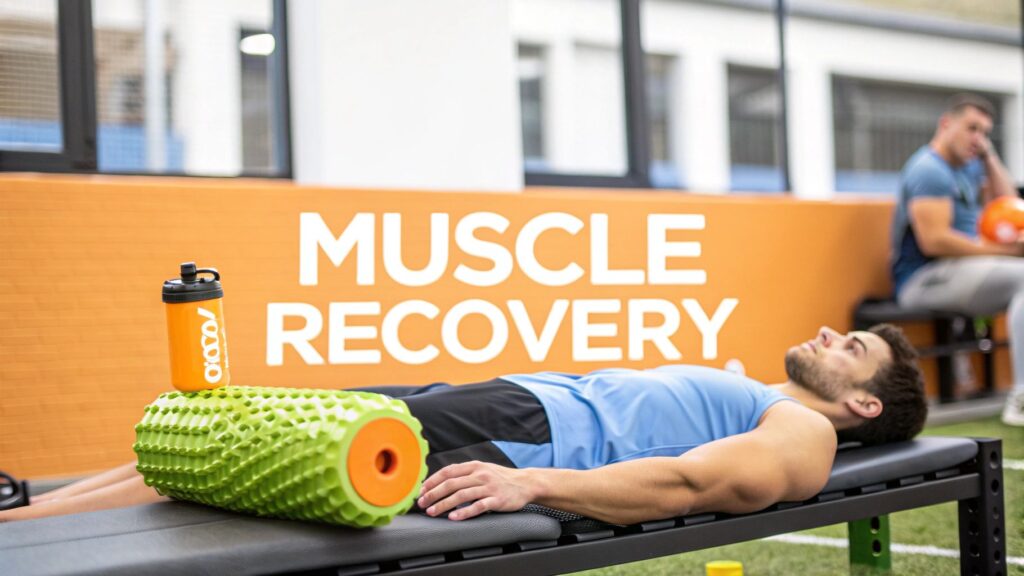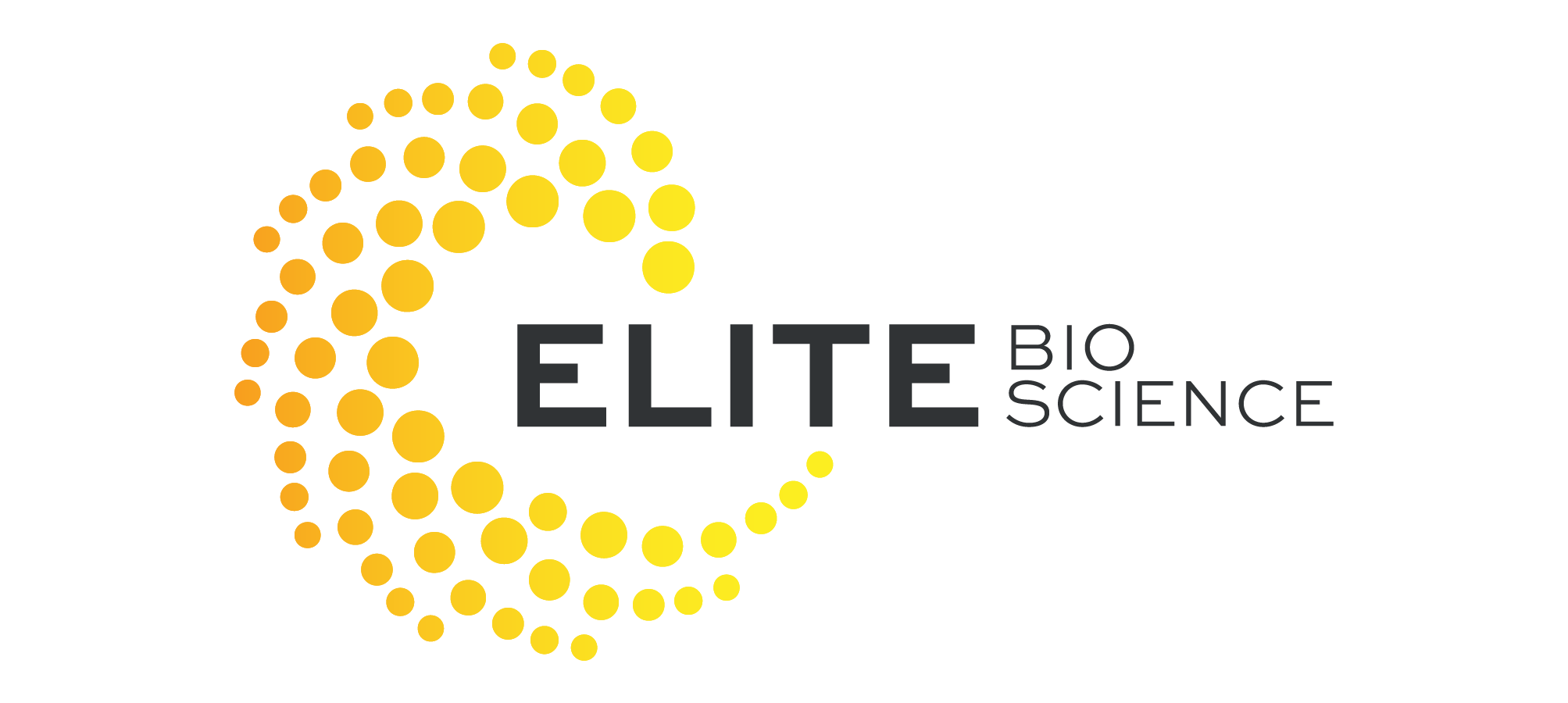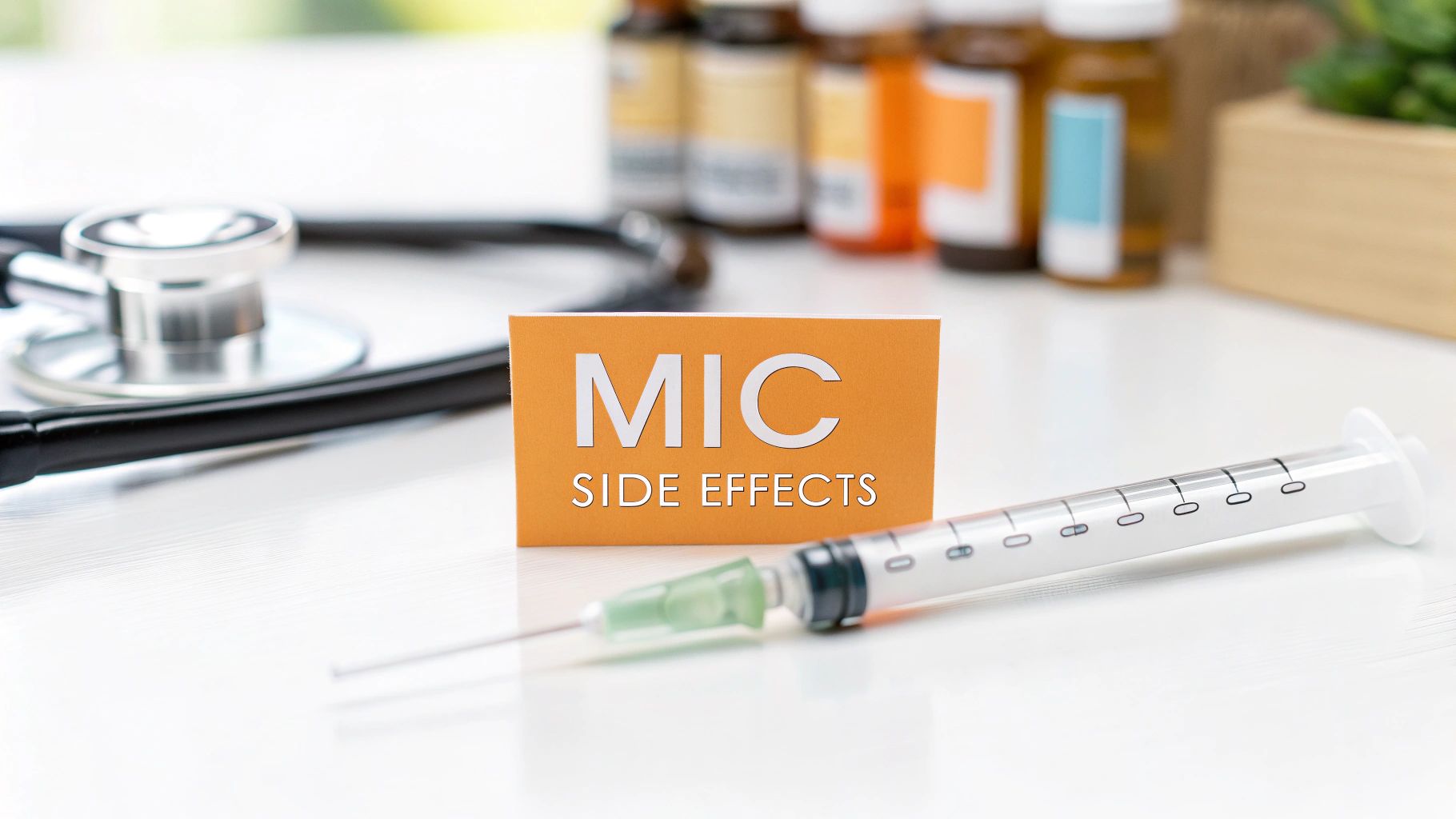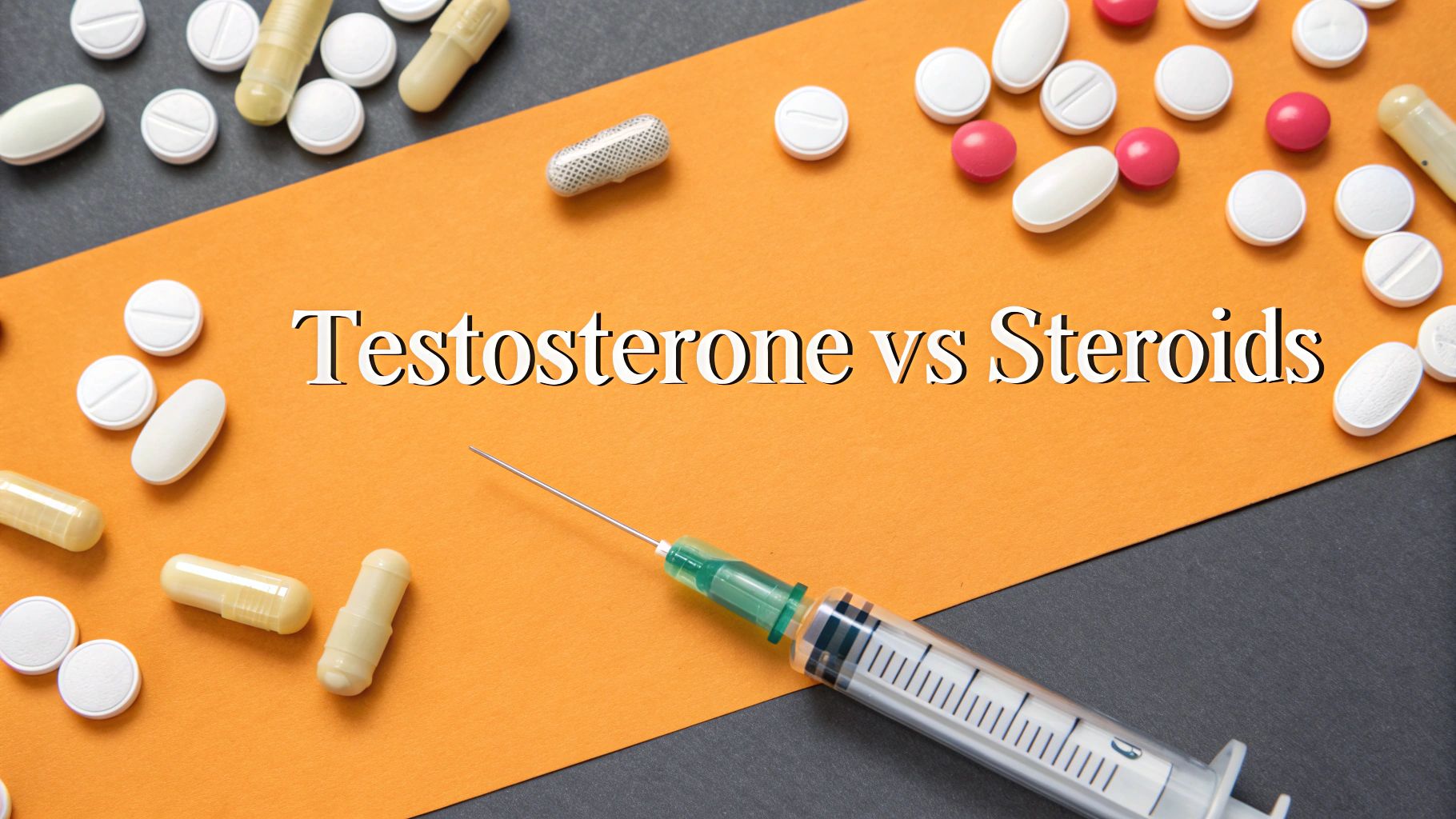How to Improve Muscle Recovery for Peak Performance

Improving your muscle recovery isn't about sitting around and waiting. It’s an active process—a strategic plan involving smart nutrition, deliberate rest, and targeted therapies. Think of it less like passive downtime and more like the crucial phase where you hand your body all the resources it needs—protein, sleep, hydration—to rebuild bigger and stronger after you’ve broken it down in the gym.
Why Smart Muscle Recovery Is Your Ultimate Training Partner

So many of us pour all our energy into punishing workouts, convinced that more intensity is always the answer. But here’s the thing most people miss: the real gains—the actual muscle growth, the new PRs, the performance boosts—don’t happen while you're lifting. They happen afterward.
Your workout is just the spark. The heavy lifting creates microscopic tears in your muscle fibers, basically sending a signal to your body that it needs to adapt. Recovery is the construction phase, where your body gets to work repairing those tiny tears, reinforcing the muscle so it can handle even more stress next time. This is how you actually get stronger.
The Real Cost of Skipping Recovery
Ignoring this critical phase is the fastest way to kill your progress. Pushing your body day in and day out without giving it the fuel and rest it needs leads straight to chronic under-recovery. Instead of building strength, you start breaking down muscle tissue, jacking up your risk of injury, and feeling wiped out all the time.
Picture a marathon runner who stacks high-mileage days back-to-back without prioritizing sleep or nutrition. At first, they feel unstoppable. But soon, their times plateau, a nagging shin pain appears, and their motivation tanks. That isn't a lack of effort; it's a failure to recover.
This burnout state, often called overtraining syndrome, has some clear warning signs:
- Persistent muscle soreness that just won't go away.
- Your performance and strength in the gym start to dip.
- An elevated resting heart rate when you first wake up.
- Trouble sleeping and a short fuse during the day.
- Getting sick more often because your immune system is suppressed.
The biggest mistake an athlete can make is to see recovery as a sign of weakness. In reality, a strategic recovery plan is the hallmark of a smart, sustainable training approach that delivers results for the long haul.
Shifting Your Mindset on Recovery
To truly master how to improve muscle recovery, you have to change how you think about it. Stop viewing recovery as something you only do when you're completely exhausted. Treat it as an active, essential part of your training schedule—just as important as your toughest workout.
This means actually planning your rest days with the same focus you plan your lifts. It means dialing in your post-workout meals and making 8 hours of quality sleep a non-negotiable priority. When you create an environment where your body can not only repair but adapt and grow stronger, you unlock consistent progress and keep yourself in the game for years to come.
Your Post-Workout Nutrition and Hydration Blueprint
Think of what you eat after a workout as the second half of your training session. You just spent an hour breaking down muscle fibers and creating the demand for growth; now it’s time to deliver the raw materials for the repair job. This is about more than just chugging a protein shake—it's a strategic refueling process that kickstarts the entire recovery cascade.
Right after you finish that last rep, your muscles are primed and ready to soak up nutrients like a sponge. This period, often called the "anabolic window," is your best opportunity to replenish spent energy and shuttle in the building blocks needed for repair. Skipping this step is like asking a construction crew to build a house without giving them any bricks or mortar. It just doesn't work.
Timing Your Macronutrients for Optimal Repair
While the old-school idea of a rigid 30-minute window has been softened a bit by research, the principle still holds true: consuming a mix of protein and carbohydrates within one to two hours post-exercise is a game-changer. These two work as a team. Carbs go to work refilling the muscle glycogen you just burned through for fuel, while protein delivers the amino acids required to patch up and rebuild muscle tissue.
A good rule of thumb is to aim for a carbohydrate-to-protein ratio of around 3:1 or 4:1. So, if you're taking in 25 grams of protein, you’ll want to pair it with 75 to 100 grams of carbohydrates. This combination gives you a nice insulin spike, and insulin is the hormone that acts like a key, unlocking your muscle cells to allow nutrients like glucose and amino acids to get inside more efficiently.
This isn't just bro-science; nutritional strategies are proven to reduce muscle damage and inflammation. Studies show that key amino acids, like BCAAs, are crucial for triggering muscle protein synthesis after a workout. Supplementing can make a real difference, with data showing that athletes using protein supplements see a reduction in delayed onset muscle soreness (DOMS) by up to 20-30%. They also get back to full strength faster than those who don't. You can dig into the data yourself by reading more about these findings on muscle recovery powders.
Building Your Post-Workout Plate
You don't need to get lost in complicated formulas to nail this. Just focus on simple, whole foods that are easy for your body to digest and put to use.
Post-Workout Meal Ideas:
- Grilled Chicken and Sweet Potato: The classic combo. You get lean protein and complex carbs that restore your energy levels without sending you on a sugar rollercoaster.
- Greek Yogurt with Berries and Honey: This gives you fast-acting protein from the yogurt, a hit of antioxidants from the berries, and quick carbs from the honey to kickstart glycogen replenishment.
- Chocolate Milk: It sounds too good to be true, but it's surprisingly effective. It naturally contains a near-perfect carb-to-protein ratio for recovery.
- Salmon with Quinoa: A powerhouse meal. You get high-quality protein and anti-inflammatory omega-3s from the salmon, paired with the complete protein and carb source that is quinoa.
Forget about chasing perfection and just focus on being consistent. The best post-workout meal is the one you actually eat after every single session. A little bit of planning is all it takes to make this a non-negotiable habit.
Don't Forget Hydration and Electrolytes
All these nutrients are useless if they can't get where they need to go, and hydration is the transportation system that makes it happen. Even slight dehydration can slam the brakes on muscle recovery by slowing down nutrient delivery and the removal of metabolic waste. Water is obviously critical, but after a really intense, sweaty session, you need to think about electrolytes, too.
Electrolytes are key minerals like sodium, potassium, and magnesium that you lose through sweat. They're vital for everything from muscle function to maintaining fluid balance.
- Sodium: Helps your body hold onto water, fighting off dehydration.
- Potassium: Is crucial for proper muscle contractions and nerve signals.
- Magnesium: Is involved in over 300 different processes in the body, including muscle relaxation and producing energy.
Instead of grabbing a sugary sports drink, try something simpler. Add a pinch of sea salt and a squeeze of lemon to your water, or just have a banana (which is packed with potassium) with your post-workout meal. Getting this foundational nutrition and hydration right is the absolute first step in any effective plan for how to improve muscle recovery.
Dialing In Your Recovery with Targeted Supplements
Once you've locked down your nutrition, you can start looking at supplements to give you a real edge. This isn't about chasing quick fixes, but making smart, evidence-backed choices to support what your body already does naturally. The right supplements don't replace hard work; they amplify it, helping to dial down soreness and speed up tissue repair.
The market for these products is absolutely massive for a reason. The global muscle recovery powder sector was valued at about US$5.6 billion in 2019 and is on track to nearly triple to US$16.9 billion by 2034. That kind of growth tells you people are serious about finding effective recovery aids. You can read more about these market projections on factmr.com.
But before we dive into supplements, let's remember the foundation they're built on: rest.

As this graphic shows, quality rest is the bedrock of physical and mental restoration. No supplement can ever replace it, but they can certainly support it.
The Proven Staples for Your Recovery Stack
Let's start with the workhorses—the supplements that are heavily studied and consistently deliver results for anyone serious about their training.
Creatine Monohydrate
This one is often pigeonholed as just a muscle-builder, but creatine is a true powerhouse for recovery. It helps your body regenerate its primary energy currency, ATP, which means your muscles can recover faster both between sets and between workouts. It also pulls water into your muscle cells, which is fantastic for hydration and jumpstarting protein synthesis.
Whey and Casein Protein
Timing your protein is a game-changer. These two are the classic one-two punch for muscle repair.
- Whey Protein: This is your fast-acting option, making it perfect for that post-workout shake. It rushes amino acids to your muscles right when they're screaming for repair materials.
- Casein Protein: Think of casein as the slow-release fuel. It digests over several hours, making it ideal for a shake before bed to feed your muscles a steady stream of aminos all night long, fighting off muscle breakdown while you sleep.
A battle-tested strategy is to hit a whey shake immediately after your workout for that rapid response, then use casein before you go to sleep to fuel overnight muscle recovery and growth.
To make things clearer, let's break down some of the most popular recovery aids and who they're best for.
Comparing Key Muscle Recovery Supplements
This table breaks down some of the most popular recovery supplements, showing what they do, when to take them, and who benefits most.
| Supplement | Primary Benefit | Best Time to Take | Ideal For |
|---|---|---|---|
| Whey Protein | Rapid muscle repair and protein synthesis | Immediately post-workout (within 30-60 minutes) | All athletes looking to kickstart immediate recovery after training. |
| Creatine Monohydrate | ATP regeneration and improved work capacity | Anytime daily (consistency is key) | Strength and power athletes aiming to recover faster between intense sessions. |
| Casein Protein | Slow, sustained amino acid release | Before bed | Anyone wanting to prevent muscle breakdown and fuel repair during sleep. |
| Tart Cherry Extract | Reduces inflammation and muscle soreness | Daily, especially on intense training days | Endurance athletes and those with high-volume training who experience significant soreness. |
This comparison highlights how different supplements serve distinct roles. Your best stack depends entirely on your training style, schedule, and specific recovery challenges.
Targeted Solutions for Inflammation and Deeper Repair
Beyond the basics, a few other compounds offer more specialized support, especially when you need to manage intense inflammation or want to accelerate tissue healing on a deeper level.
Tart Cherry Extract
If your workouts leave you feeling wrecked, this is one to look at. Tart cherry extract is loaded with antioxidants and anti-inflammatory compounds. For anyone pushing their limits with intense, muscle-damaging sessions, it can significantly cut down on that post-workout soreness and help you bounce back faster for your next workout.
Peptides for Next-Level Repair
For those looking to get even more precise with their recovery, certain peptides can play a direct role in the healing process. Peptides are short chains of amino acids that act as powerful signaling molecules in your body. They can send specific commands to accelerate tissue repair, cool down inflammation, and even encourage the release of growth hormone.
This is where recovery gets really targeted. Instead of just providing general building blocks, exploring peptides for muscle growth means giving your body's cellular repair mechanisms a direct set of instructions. It’s a more advanced strategy for anyone dead set on optimizing every aspect of their performance and recovery.
Turning Rest and Movement Into Powerful Recovery Tools
While smart nutrition and supplements build the foundation for repair, your single most effective recovery tool doesn't cost a thing. Quality sleep is the absolute non-negotiable cornerstone of any serious plan for how to improve muscle recovery. It’s during those precious hours that your body truly gets down to business, kicking off a powerful cascade of repair processes.
As you sink into deep sleep, your body cranks up its production of human growth hormone (HGH), a major player in repairing and rebuilding muscle tissue. At the same time, protein synthesis—the actual process of creating new muscle proteins to patch up the damage from your workout—shifts into high gear. Skimping on sleep is like telling your repair crew to go home early. The job just won't get done right.
The Power of Unplugging for Deeper Rest
The magic number is 7-9 hours a night, but it's not just about quantity. The quality of that sleep is what really moves the needle. That means creating an environment that screams "it's time to shut down and repair" to your brain.
To really dial in your sleep for muscle recovery, try these simple moves:
- Make Your Room a Cave: The goal is total darkness, silence, and a cool temperature. Blackout curtains and a cool room can make a surprisingly huge difference in how deep you sleep.
- Power Down All Screens: The blue light blasting from your phone and TV messes with melatonin, the hormone that runs your sleep-wake cycle. Put them away at least an hour before you plan to hit the hay.
- Lock in a Routine: Going to bed and waking up around the same time every day—even on weekends—is a game-changer. It stabilizes your internal clock, which leads to far more consistent and restorative sleep.
Think of sleep as a performance multiplier. Just one night of bad sleep can send your cortisol levels soaring and slam the brakes on muscle recovery, basically undoing all the hard work you put in at the gym. Prioritizing it gives you one of the biggest returns on investment you can make.
Why Moving Is Better Than Stopping
After a brutal workout, the urge to collapse on the couch and not move a muscle is strong. But light movement, or what we call active recovery, is often way more effective than being completely sedentary. The idea isn't to add more stress but to give your body a gentle nudge to speed up its own healing.
Low-intensity activities like a brisk walk, a slow spin on a bike, or a few easy laps in the pool get your blood circulating without putting more strain on your muscles. This increased blood flow is your best friend—it's like an express delivery service, rushing oxygen and nutrients to your sore tissues while hauling away metabolic junk like lactate that makes you feel stiff. You're essentially clearing out the construction site so the repair crew can work faster.
Foam rolling is another killer tool for active recovery. It helps release fascial adhesions—those nasty "knots" in your muscles—improving your flexibility and dialing down soreness. Spending just 10-15 minutes hitting tight spots like your quads, hamstrings, and upper back can completely change how you feel the next day.
This one-two punch of quality sleep and gentle movement creates the perfect environment for your body to bounce back stronger than before. When you pair this strategy with a solid diet, which you can read more about in this guide to the best vitamins for athletes, you've built a complete, high-performance recovery system.
When to Use Advanced Recovery Therapies

So, you’ve nailed the fundamentals—solid nutrition, consistent sleep, and smart active recovery. But you're still looking for that extra edge. This is where advanced therapies like cryotherapy, saunas, and massage guns come into play.
Think of these not as replacements for the basics, but as powerful finishers for your recovery protocol. They are specialized tools designed to target specific physiological responses, helping you manage inflammation, release deep muscle tension, and speed up your body’s natural repair cycles.
The key is knowing which tool to pull out of the bag, and when.
Cold Therapy for Acute Inflammation
Just finished a brutal leg day that left your muscles feeling hot and swollen? This is the perfect time for cold therapy.
Things like cryotherapy chambers, ice baths, or a targeted cold plunge work by constricting your blood vessels. This process helps shut down that immediate, post-workout inflammation and swelling, which can seriously numb the soreness you feel right after a session.
It’s a short-term fix, designed for immediate damage control in the hours following intense training.
Heat Therapy for Deep Muscle Relaxation
On the flip side, heat therapy is your go-to on the days after a tough workout, when everything feels tight and stiff.
Saunas and hot tubs do the exact opposite of cold: they dilate your blood vessels, boosting circulation. This increased blood flow rushes more oxygen and nutrients to your aching muscles, helping to flush out metabolic waste and relax that deep-seated tension. It's a game-changer for improving flexibility and easing that chronic stiffness before your next training block.
Consider cold therapy your immediate response team for post-workout inflammation. Heat therapy is your deep tissue mechanic, working on lingering stiffness and promoting blood flow for long-term repair.
This focus on smarter recovery isn't just a trend. The global market for muscle recovery supplements was valued at roughly US$695 million in 2025 and is projected to climb significantly. This highlights a huge shift toward preventing injuries and maximizing performance. You can dig into the numbers with these muscle recovery supplement market insights.
Mechanical Tools for Targeted Relief
Massage guns and other percussive therapy devices offer a more hands-on, mechanical approach. They are fantastic for zeroing in on specific muscle knots and trigger points with a precision that foam rollers just can't match.
Using one before a workout can help prime your muscles for action. Using it afterward helps flush out lactic acid and reduce that next-day stiffness. When you start layering these advanced therapies into your routine, you build a truly comprehensive approach to recovery. You can learn more about how to integrate these recovery methods for athletes to build a well-rounded strategy that keeps you performing at your peak.
Your Top Muscle Recovery Questions, Answered
Let's get into the questions I hear all the time about muscle recovery. These are the real-world sticking points that separate a killer training week from a frustrating one where you feel like you’re spinning your wheels.
You’ve crushed a workout, and now the simple act of walking down stairs feels like a monumental task. That deep, satisfying ache that shows up a day or two later is what we call Delayed Onset Muscle Soreness (DOMS). It’s the normal, expected result of creating those tiny micro-tears in your muscle fibers—the very tears that signal your body to rebuild bigger and stronger.
But is all soreness good soreness? Not exactly. While a bit of an ache tells you that you’ve pushed the envelope, debilitating pain that messes with your daily life for days isn't the goal. If you're consistently too sore to hit your next session with any real intensity, it’s a big red flag that you’re either pushing too hard, too fast, or your recovery game—especially nutrition and sleep—needs a serious overhaul.
Soreness vs. Injury: How to Tell the Difference
This is a critical lesson every single person who trains needs to learn. Nailing the difference between productive muscle soreness and a looming injury can be the difference between a minor tweak and months on the sidelines.
- DOMS: This feels more like a dull, spread-out ache that you can feel across the whole muscle. It’s almost always symmetrical (both quads are sore after squats, for instance) and actually feels a bit better with some light movement and blood flow.
- Injury: This is usually a sharp, specific, or even shooting pain. You can often point to the exact spot it hurts. It might show up with swelling or bruising and gets worse, not better, when you try to move it.
Here’s the golden rule I tell everyone: if the pain is sharp, localized, and doesn’t start getting better after a day or two of active recovery, it’s time to back off completely. Don’t be a hero. Get it checked out and never, ever try to "train through" a potential injury.
Tailoring Recovery to Your Training Style
Should you recover the same way after a heavy squat day versus a 10-mile run? Absolutely not. The stress you put on your body is totally different, so your recovery plan needs to adapt.
After a brutal strength session, your number one priority is getting enough protein to kickstart muscle repair and calm down your fried central nervous system. This makes quality sleep non-negotiable for a full system reboot.
On the other hand, after a long endurance effort, the focus shifts. Protein is still important, but replenishing your depleted glycogen stores with quality carbohydrates becomes mission-critical. Hydration and getting your electrolytes back in balance are also at the top of the list, since you’ve likely sweat out a ton of essential minerals.
For example, your post-workout fuel after lifting might be a high-quality whey protein shake with a scoop of creatine. After that long run, it might look more like a banana and an electrolyte drink immediately, followed by a solid meal of chicken and rice an hour or so later. Listening to your body and matching your recovery to the workout you just did is the mark of a smart athlete who’s in it for the long haul.
Ready to give your body the high-quality support it needs to recover faster and perform better? Elite Bioscience offers targeted peptide and vitamin therapies designed to optimize your body's natural repair processes. Explore our solutions and take your recovery to the next level at https://elitebioscience.co.
QUICK SEARCH
Make an account today to start your journey towards a better and healthier lifestyle.






